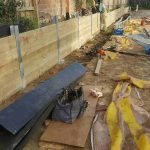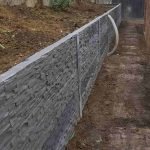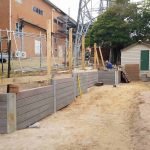Introduction
When it pertains to landscaping and building and construction, among the most crucial elements to think about is the type of soil on your residential or commercial property. Understanding soil types with your retaining wall installer's help can make a significant distinction in guaranteeing the stability and durability of your retaining wall. Retaining walls serve not just as visual improvements however also play a crucial role in handling soil disintegration and offering support in sloped areas. This guide will dig deep into the complexities of soil types, their characteristics, and how they communicate with various materials like timber sleepers, concrete sleepers, and H beams

Understanding Soil Types with Your Retaining Wall Installer's Help
What Are Soil Types?
Soil types are classified based on their physical and chemical properties. They can be broadly classified into sandy, clayey, silty, loamy, and peaty soils. Each type has its own special qualities that affect drainage, compaction, and overall stability.
Why Is Soil Type Essential for Keeping Walls?
The type of soil directly impacts the design and installation of keeping walls:
- Drainage: Some soils retain water while others permit it to drain quickly. Weight: Different soil types have varying weights that can put in pressures on the maintaining wall. Erosion: The susceptibility to erosion varies with each soil type.
Common Soil Types Explained
Sandy Soil
Sandy soil consists of big particles that produce large areas in between them. It drains quickly but may not hold nutrients well.
Pros:
- Excellent drainage Easy to work with
Cons:
- Low nutrient retention Susceptible to erosion
Clayey Soil
Clayey soil consists of really great particles that are tightly compacted. It keeps water but drains poorly.
Pros:
- High nutrient retention Good for certain plant growth
Cons:
- Poor drainage Can expand or shrink significantly with wetness changes
Silty Soil
Silty soil is comprised of medium-sized particles that are smooth to the touch. It holds moisture much better than sandy soil however drains poorly.
Pros:

- Good nutrient retention Holds moisture well
Cons:
- Compacts easily Susceptible to erosion when wet
Loamy Soil
Loamy soil is a mixture of sand, silt, and clay. It is often thought about the ideal garden soil due to its balance of drainage and nutrient retention.
Pros:
- Excellent drain Nutrient-rich
Cons:
- Can be costly if bought
Peaty Soil
Peaty soil consists of a great deal of raw material, making it dark in color. It's normally found in damp areas.
Pros:
- Rich in nutrients Great for particular plants
Cons:
- Poor drainage Can be acidic
Choosing the Right Product for Your Retaining Wall
Timber Sleepers vs. Concrete Sleepers
When structure a retaining wall, you have a couple of product choices - timber sleepers or concrete sleepers Each has its benefits depending upon your specific needs.
Timber Sleepers
Timber sleepers offer a natural appearance that mixes well with gardens.
Advantages:
Aesthetic appeal. Easier to handle during installation. Cost-effective option.Disadvantages:
Prone to rot over time. May need more maintenance.Concrete Sleepers
Concrete sleepers offer durability and strength for larger walls or walls developed on unstable soil conditions.
Advantages:
Long-lasting. Requires less maintenance. Suitable for numerous designs.Disadvantages:
More pricey than timber. Heavier, requiring more labor during installation.H Beams as Structural Support
For vertical loads or additional structural support in your retaining wall system, using H beams can be beneficial.
Benefits of H Beams:
Provide additional strength against lateral earth pressure. Ideal for steep slopes where extra reinforcement is necessary. Versatile usage in conjunction with both wood or concrete systems.Soil Analysis Before Installation
Why Conduct a Soil Test?
Conducting a soil test before installing your retaining wall is vital due to the fact that it assists recognize:
Soil composition (sand, silt, clay). pH levels affecting plant growth. Drainage abilities which affect wall design.How to Conduct a Soil Test?
You can either employ experts or do it yourself:
Collect samples from numerous locations at different depths. Use an at-home kit or send out samples to a lab for in-depth analysis. Review results carefully; consult your installer for interpretation related to construction plans.The Function of Your Retaining Wall Installer
Choosing a Professional Installer
Hiring a professional installer makes sure that all elements-- from soil screening to wall construction-- are dealt with expertly.
What Makes an Installer 'Professional'?
Experience in different types of setups (timber sleeper vs concrete sleeper). Knowledgeable about regional regulations and building codes. Strong portfolio showcasing previous projects.Questions to Ask Your Installer
Before committing:
What is your experience with various soil types? Can you supply references? What materials do you advise based upon my particular situation?Design Considerations Based on Soil Type
Factors Influencing Style Choices
When designing your retaining wall, consider these aspects based on your specific soil type:
1. Height & & Load Bearing Capacity
Taller walls require tougher products like concrete sleepers or H beams for structural stability in clayey soils prone to expansion under moisture changes.
2. Drain Solutions
Including perforated pipes behind the wall can assist handle water pooling behind walls constructed on sandy soils where fast drain is possible however requires careful planning around stability issues linked with heavy rains affecting fertile soils too!
Construction Process Overview
Steps Involved in Building a Retaining Wall
Building any kind of retaining wall includes several steps:
1. Preliminary Consultation
Discuss objectives & & issues concerning landscape features requiring support together with preferred styles/materials such as timber/concrete alternatives available within spending plan constraints!
2. Website Preparation
Clear location & & ensure proper grading towards drainage outlets; mark out boundaries precisely before digging begins!
3. Foundation Laying
A strong foundation supports long-lasting performance-- especially crucial when using heavier products like H beams!
4. Wall Construction
Install selected material (timber/concrete) according to design specifications; include essential reinforcements if needed!
5. Last Touches
Add any finishing touches preferred-- like caps atop concrete walls! Do not forget landscaping around base either!
FAQs about Retaining Walls and Soil Types
Q1: How do I know what kind of soil I have?
A1: A professional service can conduct a comprehensive analysis; additionally, do it yourself kits are readily available online for fundamental testing!
Q2: Can I install my own maintaining wall?
A2: While possible if experienced enough-- hiring professionals frequently saves headaches later on down roadway by ensuring whatever fulfills regional codes!
Q3: For how long will my retaining wall last?
A3: Depends greatly on materials used; lumber may last 10-- twenty years while concrete might last over 50 years if appropriately maintained!

Q4: What occurs if my wall collapses?
A4: Routine examinations assist identify early indication before collapse occurs; speak with engineers right away upon discovering any shifts/sinking!
Q5: Is plant life handy near retaining walls?
A5: Yes! Specific plants can support surrounding earth while likewise enhancing aesthetic appeals but must choose carefully based upon root depth & & spreading tendencies!
Q6: Do I require permits before building?
A6: Often yes-- however check regional policies first considering that requirements differ commonly throughout municipalities concerning height/location constraints and so on!
Conclusion
In summary, understanding different elements associated particularly towards "Comprehending Soil Types With Your Retaining Wall Installer's Aid" plays an essential role when launching this journey! From knowing how different products perform against unique ground conditions through examining underlying earth composition prior engaging professionals-- each factor contributes towards attaining effective outcomes! Ultimately investing time upfront pays off down road yielding aesthetically pleasing yet https://louisprofessionalgcyo516.mystrikingly.com/ structurally sound services customized exactly according respective website difficulties experienced throughout procedure ahead!